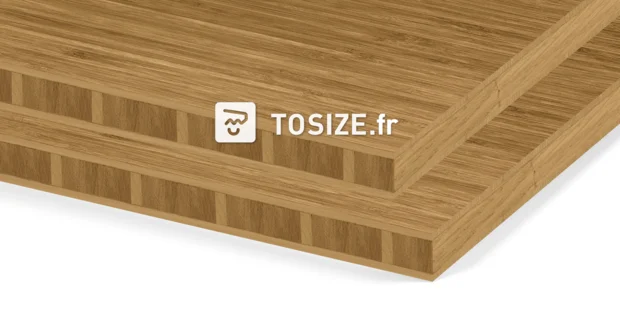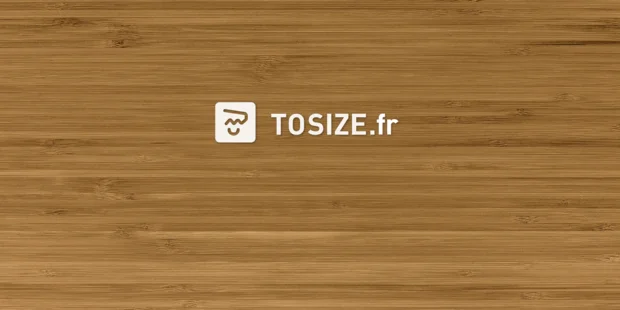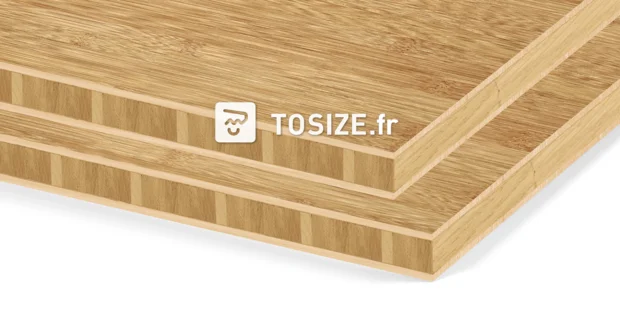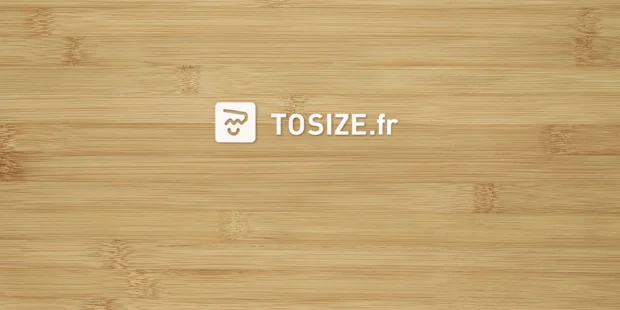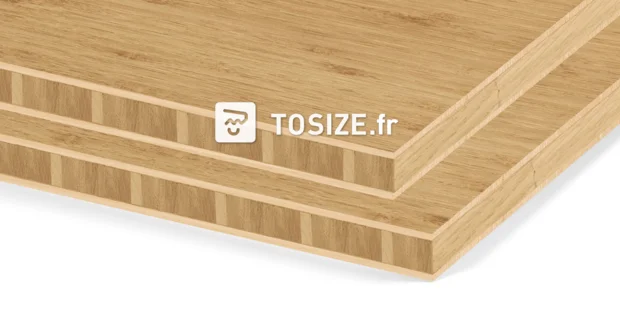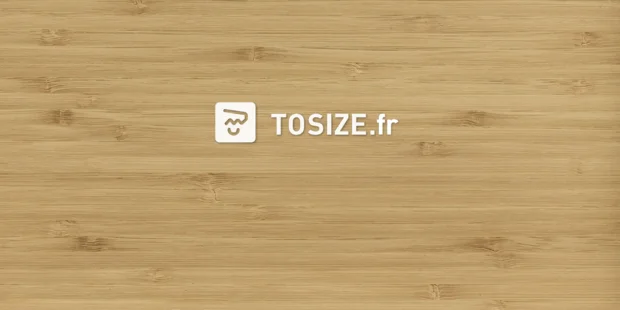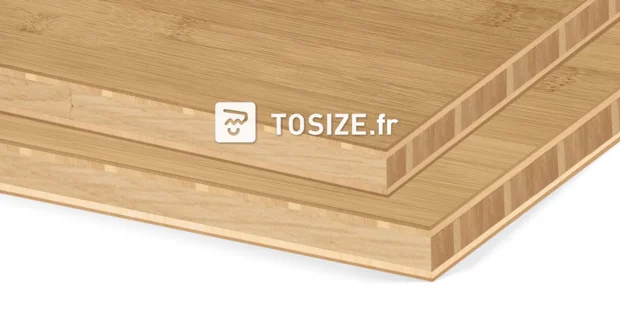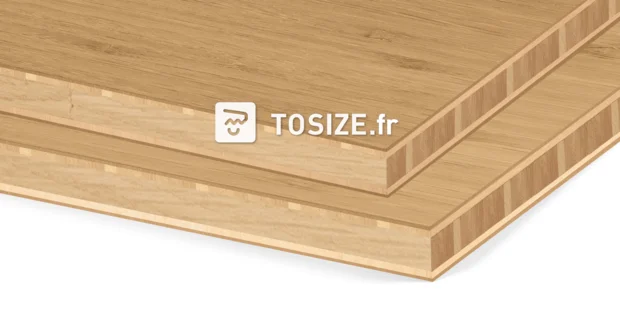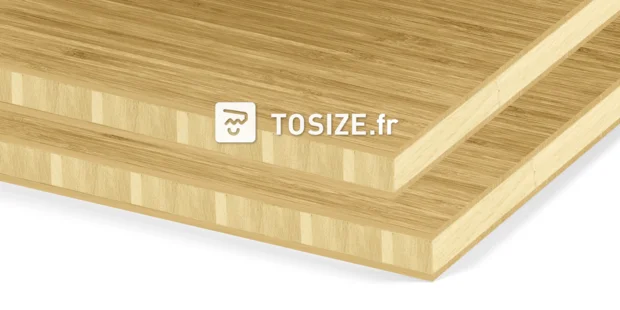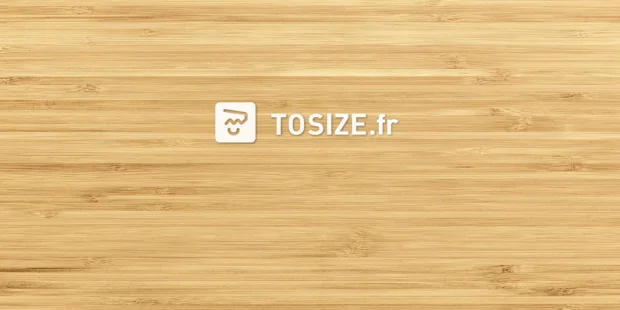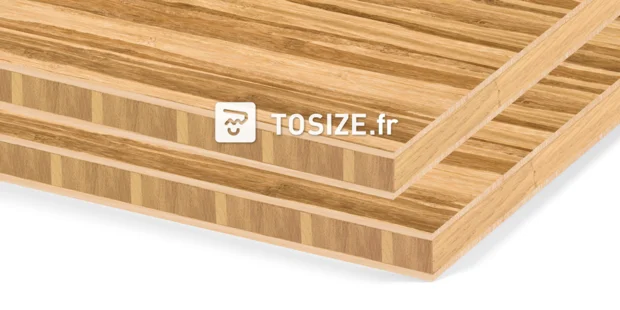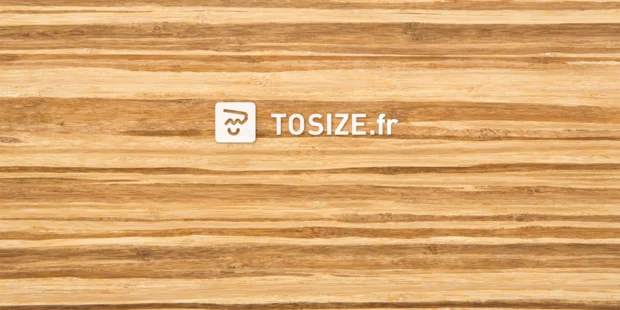- TOSIZE.fr
- Wood and sheet material
- Timber boards
Bamboo Natural 3L Plain pressed
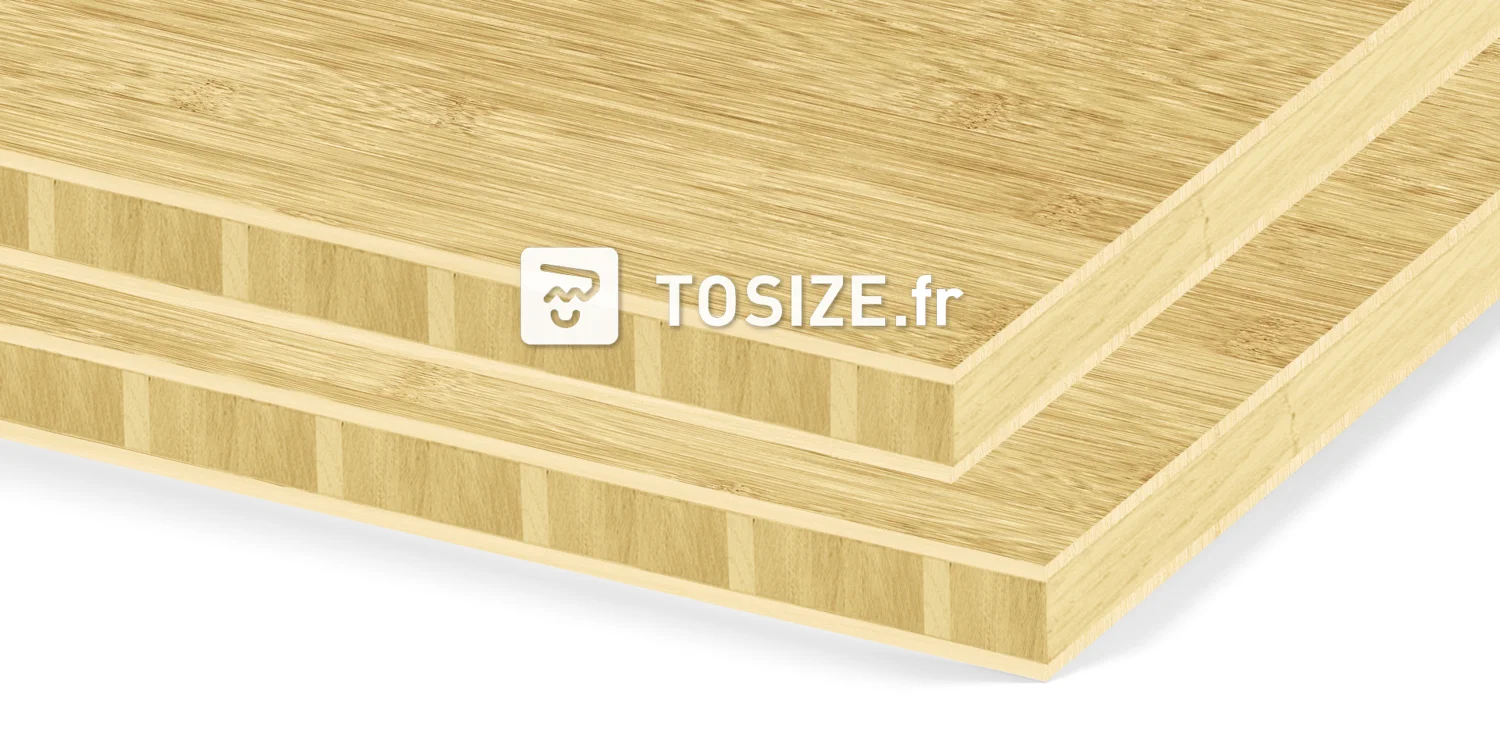
Product information
- Quirky and natural look
- High-grade quality
- Works less than other types of wood
- Hard board material with high durability
- Easy to treat with stain, lacquer or oil
- Can discolour when in contact with iron
- Bamboo can vary in thickness by up to 10% due to temperature differences
- There can be colour differences per panel
Description
Bamboo Natural 3L Plain pressed is a solid board with high strength and stability. It is also durable, versatile and this board material has an attractive natural appearance. Bamboo is stronger than many traditional woods and has higher resistance to moisture and warping. Moreover, bamboo is a sustainable and renewable resource that grows quickly and requires little maintenance.
Bamboo panel material can be used for various applications, including flooring, furniture, wall covering, but obviously for much more!
This panel consists of 3 layers. A strong core with two top layers with a plain pressed look. Plain pressed bamboo has a uniform appearance because the bamboo strips are placed vertically next to each other before being pressed and glued. This creates a smooth surface without the distinctive linear pattern of side pressed bamboo. However, a clear bamboo pattern is still present. A soft yellow-coloured slab with a natural look. Looking for this slab? Start configuring immediately.
Best alternatives for this product:
How convenient is that
Product information
- Quirky and natural look
- High-grade quality
- Works less than other types of wood
- Hard board material with high durability
- Easy to treat with stain, lacquer or oil
- Can discolour when in contact with iron
- Bamboo can vary in thickness by up to 10% due to temperature differences
- There can be colour differences per panel
Description
Bamboo Natural 3L Plain pressed is a solid board with high strength and stability. It is also durable, versatile and this board material has an attractive natural appearance. Bamboo is stronger than many traditional woods and has higher resistance to moisture and warping. Moreover, bamboo is a sustainable and renewable resource that grows quickly and requires little maintenance.
Bamboo panel material can be used for various applications, including flooring, furniture, wall covering, but obviously for much more!
This panel consists of 3 layers. A strong core with two top layers with a plain pressed look. Plain pressed bamboo has a uniform appearance because the bamboo strips are placed vertically next to each other before being pressed and glued. This creates a smooth surface without the distinctive linear pattern of side pressed bamboo. However, a clear bamboo pattern is still present. A soft yellow-coloured slab with a natural look. Looking for this slab? Start configuring immediately.
Product properties
Applications
- Tables
- Cupboards
- Bookshelves
- Floor panels
- Wall panels
- Desks
- Stair treads
- Boxes, barrels and vats
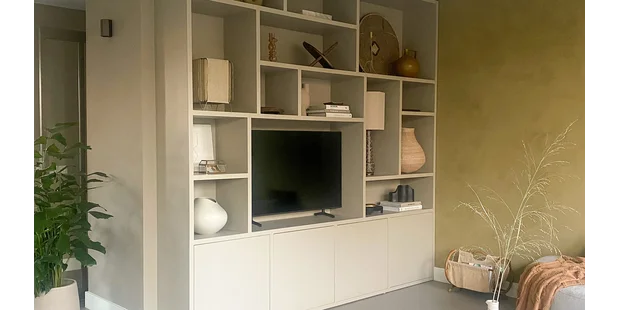
Order Bamboo Natural 3L Plain pressed made-to-measure sheets online
Order cut-to-size Bamboo Natural 3L Plain pressed easily online. Bamboo is a durable and strong material that is increasingly used in interior and furniture design. Cutting bamboo panel material to size at TOSIZE.fr allows you to tailor your design perfectly to your specific needs and requirements. We deliver the panel fully cut to size at home. Are you curious about the possibilities? Configure your product, and you will have your project ready in no time.
Bamboo Natural 3L Plain pressed: what is it?
Bamboo board material is a durable and versatile alternative to traditional wooden board material. It is made from bamboo strips glued and pressed together in layers, creating a sturdy and stable material. Bamboo is by nature a fast-growing plant that requires much less water and nutrients than other types of wood. In addition, bamboo is self-healing and grows back quickly after cutting, making it a sustainable choice. Bamboo board material is increasingly used in interior and furniture design because of its natural look and strength. It is available in different thicknesses, sizes and finishes, making it suitable for different projects. Cutting bamboo board material to size allows designers and makers to perfectly tailor the material to their specific needs and requirements.
Bamboo Natural 3L Plain pressed, sheet material with a natural look
Unlike melaminated material, bamboo is not a plastic but a natural product. This gives the material a calm, natural look. Because it is a natural product, there may be colour and texture differences between different panels. No two panels are the same. It is also important that this panel is finished with a lacquer, stain, wax or oil as desired. This prevents discolouration and preserves the top layer.
Bamboo
Bamboo is growing tremendously in popularity! So is the sale of wood panels with a bamboo top layer. Known for its rapid growth, this material is a popular product if you are looking for a sustainable look-and-feel for your space. Did you know that bamboo was a collective name for a number of different panel types? As a result, there are several bamboo colours available. Check out all the options in our product range.
Bamboo is officially not a real wood, but a type of grass. Its shape is naturally round and hollow. To make it into sheet material, pressed bamboo fibres are used. The material is cooked and then pressed so that it can be used as sheet material and veneer. As it remains a natural product, the thickness per panel or veneer may vary by a few millimetres from the indicated thickness.
Side pressed, plain pressed of density
Cutting bamboo is usually done in two different ways: side pressed or plain pressed. The difference between side pressed and plain pressed bamboo has to do with the way the bamboo strips are arranged before being pressed and glued to make the panel material. As you may know, bamboo grows in round stems or sticks. There is also a third variant: density. Below, you can read about the differences between the appearances and properties.
With side pressed bamboo, the bamboo strips are placed horizontally next to each other, creating a visible linear pattern on the surface of the panel material. In this case, the well-known nodules are clearly visible in the structure. This pattern gives the bamboo a characteristic and natural look and is often used for flooring, wall panels and furniture.
Plain pressed bamboo, on the other hand, has a more uniform appearance as the bamboo strips are placed vertically next to each other before being pressed and glued. This creates a smooth surface without the distinctive linear pattern of side pressed bamboo. Plain pressed bamboo is often used for kitchen worktops, table tops and other interior design.
Both types of bamboo have their own unique properties and appearance, so the choice depends on the specific design and desired look. Side pressed and plain pressed are often compared, but there is also a third important one: density. As the name suggests, bamboo density is high density pressed bamboo. The higher the density, the heavier and stronger the bamboo panel material is. Also, keep in mind that density bamboo has a darker appearance than its peer side pressed or plain pressed. In addition, you may find the structure of density pressed bamboo busier and more unstructured than side or plain pressed bamboo. A matter of taste as to which one you prefer.
Different colours of bamboo: natural, ecru, caramel or tiger
The difference between natural, caramel and tiger-coloured bamboo has to do with how the bamboo is treated and produced.
Natural bamboo, ecru bamboo, caramel bamboo and tiger bamboo are different varieties of bamboo, each with its own distinctive colour and appearance characteristics:
Natural bamboo
- Natural bamboo has a natural, light colour similar to the natural colour of untreated bamboo.
- It usually has a pale, light yellow to beige colour.
- Retains the natural look and grain pattern of the bamboo.
- This variety retains the original colour and appearance of bamboo without the addition of dyes or finishes.
Ecru bamboo
- Ecru bamboo is a light and warm colour that resembles unbleached bamboo fibres.
- It is a soft, earthy colour and has a mix of beige and cream tones
- It exudes a natural, calm look.
- Ecru bamboo is often associated with sustainability and environmental awareness because of its connection to bamboo as a renewable resource.
Caramel bamboo
- Caramel bamboo has a rich, warm colour that resembles caramel or honey.
- It is treated with a special heat treatment technique to caramelise the sugars in the bamboo.
- This variety has a deeper shade compared to natural or ecru bamboo and can range from light caramel to deeper coppery colours.
Tiger bamboo (also called striped bamboo)
- Tiger bamboo is named for its distinctive stripes or spots on its surface.
- It is a special type of bamboo where the outer layer of the bamboo is removed before pressing. This results in a unique striped pattern of lighter and darker colours.
- These stripes are often darker in colour than the main colour and give the bamboo a tiger-like appearance.
- The colour can range from natural to ecru or even caramel, while the darker stripes create the tiger-like texture.
- This panel has a striking and unique pattern.
Choosing the right colour bamboo depends on the specific design and desired look. For example, Natural or Ecru bamboo goes well with a minimalist or Scandinavian interior, while caramel or tiger bamboo has a warmer and richer look and goes well with a more traditional or exotic interior.
Available thicknesses of Bamboo Natural 3L Plain pressed
With us, you order high-quality customised bamboo panels in various thicknesses. You can easily specify the desired thickness in the product configurator. The thickness does depend on the construction of the layers and the look you are looking for. We can supply this plate in the following thicknesses:
1-layer, 3-layer or 5-layer bamboo
Bamboo boards are available in different thicknesses. Besides the thickness, the construction can also differ. Typically, you will find three different types of construction of bamboo boards: 1-layer, 3-layer and 5-layer boards. The difference between 1-layer, 3-layer and 5-layer bamboo has to do with the number of layers of bamboo strips used to make or press the panel material.
1-layer bamboo is made by placing some bamboo strips horizontally next to each other and then pressing them together to make 1 slab. This type of bamboo panel material usually has a thickness of 3 to 6 millimetres and is often used for decorative applications or employed as a finish for wall panels.
3-layer bamboo is made by gluing three layers of bamboo strips together vertically or crosswise. Depending on which cross-section you look at, see thin strips or tight, long lines. The result is a strong and stable panel material with a thickness of between 18 and 22 millimetres. 3-layer bamboo is often used for flooring, furniture and kitchen worktops.
5-layer bamboo is the thickest type of bamboo panel material and is made by gluing five layers of bamboo strips together vertically or crosswise. This results in a panel material with a thickness of 30-40 millimetres and very high strength. 5-layer bamboo is often used for construction applications, such as support beams and support pillars.
The number of layers of bamboo used affects the thickness, strength and stability of the panel material. It is important to choose the right type of bamboo suitable for your project.
Processing Bamboo Natural 3L Plain pressed boards
Working bamboo board material is not difficult, but it is important to bear in mind some important details regarding tools. Preferably, use a saw blade with fine teeth and use sharp tools to avoid cracks or damage. In addition, bamboo can sometimes splinter during sawing. Therefore, before sawing, stick tape over the sawing area to prevent splintering. Also consider the direction of the bamboo fibres.
Will you be assembling bamboo? If so, use suitable fasteners: Bamboo board material can be fixed with screws, nails, glues or clamps. To prevent the bamboo panel material from splitting, it is important to pre-drill holes before using screws.
Specific uses of bamboo
Bamboo can be used for many applications. Bamboo board material should acclimatize in the room where it is installed to adapt to temperature and humidity. Leave the board material in the room for at least 48 hours before installing it. In addition, it is always important to ensure a flat and stable surface: To prevent the bamboo panel material from warping or bending, it should be installed on a flat and stable surface.
For applications where strength and durability are important, such as flooring, wall panels or furniture, higher density bamboo panel material is often chosen, and thus the density variant. For lighter applications, such as decorative panels or partitions, lower-density bamboo may be sufficient. In addition, keep in mind that bamboo panel material can be sensitive to moisture. Ensure adequate ventilation in the room to prevent moisture build-up.
Bamboo board material can be maintained by cleaning it regularly with a damp cloth and mild soap. Avoid using abrasive or harsh detergents that may damage the surface of the bamboo.
Alternatives to Bamboo Natural 3L Plain pressed
Isn't Bamboo Natural 3L Plain pressed the right type of wood for your job after all? Looking for plywood with a grain? Then go for poplar plywood. Do you want boards that can be used outdoors? Then also check out phenolic plywood, MDF tricoya or multiplex okoume. Or check out our other board materials here:

